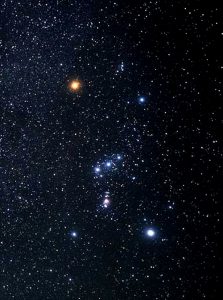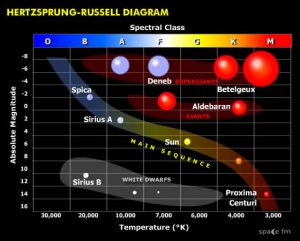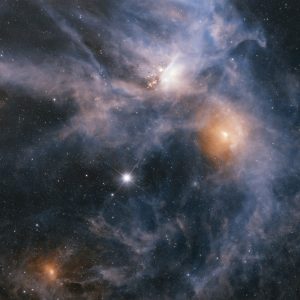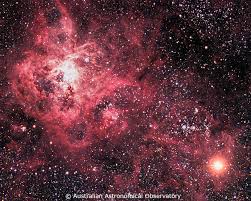There has been quite a bit of discussion of late regarding the dimming of the star α Orionis (Alpha Orionis) or commonly known as Betelgeuse.

Betelgeuse is a semi-regular variable Supergiant Star that is located to the upper right of the attached Hertzsprung-Russel diagram. It is classified as spectral class M1-M 2-1a to ab. The classification depends on where, in the variability cycle, the star happens to be when observed.
The star is evolved, hence it being a Red Supergiant, but don’t be lulled into thinking a star is red due to its age, or in fact its size, although these are factors in Betelgeuse’s case. Stars of all sizes can be any of the spectral classes (O-B-F-A-G-K-M).

The colour of a star is indicative of the temperature of the photosphere, or visible surface. The age is only a secondary indicator. Red giants, or red galactic hyper giants are red simply because they are very bloated and their outer layers cool down. Red dwarves are compact, but produce little energy, compared to larger stars, thus their surfaces are cooler than our Sun and appear Redder. (Again, see the H-R diagram attached)
Red stars have surface temperatures between 3200°K and 4600°K. Stars are classified by their colour temperature using the spectral classes;
O = 40,000°K plus
B = 15,000 to 30,000°K
A = 7500 to 9500°K
F = 6500 to 7500°K
G = 4800 to 6400°K
K = 3300 to 4600°K
M = 2800 to 3200°K
The OBAFGKM spectral sequence has recently been extended to include class L (objects with temperature around 2000 Kelvin) and class T (with temperature less than 1300 Kelvin). Objects of spectral type L and T are not (technically speaking) stars at all, since they are not hot enough for fusion to occur in their cores. These are the brown dwarfs that are sometimes referred to as failed stars.
Betelgeuse is likely variable due to pulsations, caused by convection in the photosphere,visible surface, these variations can cause the star to vary from +0.0 to +1.5 visual magnitude. Currently the star is around 1.2 magnitude (+/-0.25 mag). (Thanks to Tom Polakis for the corrected light curve data)
The mass of Betelgeuse, and the distance to the star, have been a hot topic for a long time. It was once believed to be physically associated with the Orion OB1 association and at a distance of around 1500 light years (460 parsecs), this would put the mass of the star as high as 50 solar masses, a true Galactic giant. However, in recent decades both these figures have been corrected downwards thanks to more accurate parallax measurements.
Data from both the Hyparcos and Gaia missions indicates it to have been ejected from the Orion OB1 association and is rushing though space at a speed of +30km/s relative to Earth, creating an almost 4 light year wide bow shock in the surrounding space and that Betelgeuse to be around 640 (=/-15) light years (196 parsecs), which would indicate a mass of range of 17 to 25 solar masses, however a new approach to mass calculation for single stars has indicated a mass of 11(+/-3) solar masses. The mass determination is a critical factor is calculating the life span of the star.
The star is believed to be approximately 10 million years old and moved off the main sequence between 500,000 years and 2 million years ago, this uncertainty is a result of the mass uncertainty. Stars of 10 solar masses will live up to 20 million years, but stars of 20 solar masses may only live for a maximum of 10 million years. Without knowing the exact mass of Betelgeuse, it is hard to estimate how long it is before it undergoes the core collapse phase.
Most researchers believe that Betelgeuse will one day end it’s days in a spectacular type II supernova, and that this can be expected no sooner than 10,000 years but no later than 1 million years in the future, however, this is not certain either, some researchers believe that some stars below around 20 solar masses may be able to shed enough material in their Red Supergiant phase to avoid the catastrophic core collapse that is required for a supernova to occur – this is dependent on the amount of mass the star is able to shed via the stellar wind and other processes, if the star still has a final mass <8 solar masses, then core collapse is inevitable and so is a supernova explosion.
Whilst Betelgeuse may become a supernova, it is not the only star in the sky capable of this, Antares is an M1.5-1a to 1b Red Supergiant that is also around 10 million years old and some 550 light years (168 parsecs), with a mass ranging from 11-14.3 solar masses, it is also approaching the end of it’s life and would be a supernova even brighter than Betelgeuse due to the proximity of the star.
These stars are so far away they present no danger to live on Earth, Yes, after a few million years, there may be a slightly higher influx of charged particles from their direction, but unless you were naked in space, they would not present any greater hazard than the normal background radiation – and if you were naked in space, you would be dead so it’s an irrelevance.
There are around 37 stars that are visible to amateur equipment, some even the naked eye, that are believed to be supernova candidates, in fact, Rigel A, also in Orion, is one of them, a B8-1a Blue Supergiant with a mass at least 21 times that of the Sun. It was once believed that only Red Supergiants exploded as supernova, then in 1986 Sanduleak-69+202, a Blue Supergiant star in the Large Magellanic cloud exploded without any warning, it became Supernova SN1987A, thus changing how we understood which stars will or can erupt as supernova.
I hope this post clears up any concerns anyone has about Betelgeuse and the recent hype about the star becoming a Supernova, and any threat it may pose to life on Earth.
EDIT:
Tom Polakis, of The Lowell Observatory, supplied an updated data set from the AAVSO which give an accurate figure for the visual magnitude of Betelgeuse.




